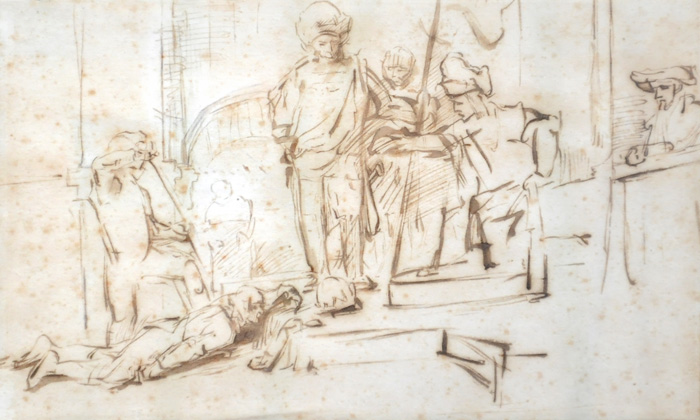MARINA DEL REY, Calif. — It wasn’t some bold theft carried out by burglars breaking into a heavily-fortified museum with high-tech alarms to swipe a masterpiece. It was a low-tech caper involving a distraction, an accomplice or two and a small sketch — an 11-by-6-inch drawing.
What was remarkable was the signature on the artwork: Rembrandt.
Authorities said early today they had recovered the Dutch master’s 17th century sketch at a San Fernando Valley church, about 20 miles from the luxury hotel lobby where it was snatched over the weekend from a private art display while a curator was momentarily distracted by someone who seemed interested in buying another piece.
“When the curator turned back to the Rembrandt, it was gone,” said Los Angeles County sheriff’s spokesman Steve Whitmore. It was not clear whether the person talking to the curator was connected to the theft, though Whitmore said a team of at least two people was involved.
Detectives got a tip from an anonymous caller on Monday evening that the sketch was in the suburban Encino church, he said. A curator confirmed the artwork’s authenticity at 12:05 a.m. Tuesday. At a news conference held at dawn Tuesday, authorities said nobody had been arrested. They did not release the name of the church.
The Rembrandt drawing, swiped Saturday night, was valued at $250,000 and was being exhibited as part of a private display in the Ritz-Carlton Hotel in the upmarket seaside community of Marina del Rey.
The sketch was being displayed on an easel or wooden stand and was apparently not fastened down in any way, Whitmore said.
He described the theft as well-executed, “but not executed well enough to get away with,” adding that investigators had several strong leads and that detectives were looking at video surveillance from the hotel.
The sketch, called “The Judgment,” was completed around 1655 and is signed on the back by Rembrandt von Rijn. He is widely regarded as one of the finest painters in European art history and his worldwide name recognition has made his work a common target for thieves.
“Rembrandt is a name that criminals know or should know,” said Chris Marinello, executive director of the London-based Art Loss Register, an international database of stolen artworks. “When they come across one, they see dollar signs.”
Marinello said the theft was likely a crime of opportunity and not an operation carried at the command of a mysterious underworld mastermind with a private art collection, as is often depicted in movies.
“Hollywood would love us to believe there are paintings being ordered stolen,” he said. “We have yet to find that.”
Artworks tend to surface either very quickly after they are stolen or else disappear into the underworld where they are traded between criminals at a fraction of their value for drugs and other illicit materials, Marinello said.
Ritz-Carlton spokeswoman Vivian Deuschl said she could not comment because the theft was a police matter.
The drawing was part of an exhibit at the hotel sponsored by the Linearis Institute based in the San Francisco Bay area community of Hercules. Messages left Monday weren’t returned.
The stolen sketch was drawn with a quill pen and depicts what appears to be a court scene with a man prostrating himself before a judge.
Marinello said the artist thieves most commonly target is Picasso because of the volume of the Spanish painter’s work and his name recognition.
In July, a thief walked into a San Francisco gallery and snatched a Picasso sketch valued at more than $200,000. The arrest of the suspect ultimately led police to a trove of other stolen artworks in a New Jersey apartment.
In 1990, two criminals posing as police officers robbed the Isabella Stewart Gardner Museum during the St. Patrick’s Day parade in Boston. Marinello said the works, which included Rembrandt’s only seascape, had a combined worth of as much as $500,000. Those paintings are still missing.
Anthony Amore, chief investigator at the museum and co-author of the book “Stealing Rembrandts,” told the Los Angeles Times there have been 81 documented thefts of the artist’s work in the past 100 years.
Send questions/comments to the editors.



